The Brussels' Atomium
The Brussels' Atomium is made of eight spheres placed at the vertices of a cube, and another sphere placed at its center. These spheres are connected by twenty tubes, twelve of them corresponding to the cube edges, the other eight connecting the central sphere with the spheres on each vertex, along the main diagonals.
The cube is placed over a vertex, in such a way that a main diagonal is vertical. The real building has supports for the bottom sphere (which rests over an auxiliary building), and for the three vertex spheres connected to the bottom one.
The article on the cube, at MathWorld, states that the Brussels' Atomium is the biggest cube in the world, and also includes a picture and some of its measurements.
We will use rhombicosidodecahedra as spheres. Firstly, they are round enough objects, and of intermediate size, not too small, not too large. Also, and this is the key property, they contain the geometrical elements of the cube, even if they aren't obvious.
When we choose, among its thirty square faces, a random one, we will immediately find another opposite parallel square face, and four additional ones making right angles with them, in the same positions as the faces in a cube. In the left-hand picture, we have marked such a set of six faces by building on them prolongations made up of blue rods. But there are five different such sets, one for each of the squares surrounding each of the pentagonal faces.
Choosing one of these sets to be the faces of a cube, determines another set containing eight triangular faces pointing to the vertices of the very same cube, as we show in the right-hand picture by using prolongations made up of red rods. Hence, there are five such eight triangle sets. There are not forty triangles, however, just twenty, as each triangle belongs in two different sets.
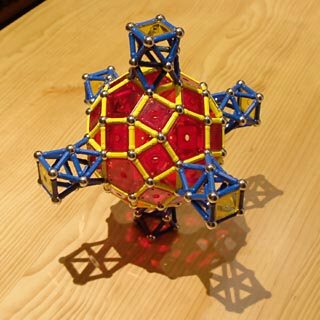
Planes of the cube in a rhombicosidodecahedron
|
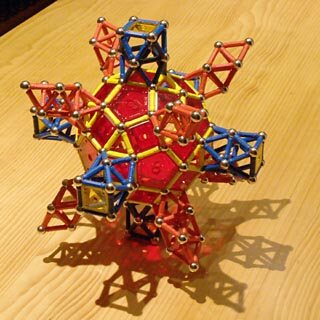
Planes and vertices of the cube in a rhombicosidodecahedron
|
In principle, this means that we could connect vertex spheres with each other by using square «tubes», and with the central sphere by using triangular «tubes». The simplest and strongest way of building such tubes would be by using square and triangular antiprisms, respectively.
However, it is not possible to include the central sphere in the model using these elements. Given the fact that connection tubes must be made of whole numbers of antiprisms, and given the measurements of the rhombicosidodecahedron inradiuses (distances from the body center to the face centers), it can be mathematically shown that a central sphere cannot be fitted.
Forgetting about a central sphere, though, the design is clear. We built the model using tubes made of four antiprisms. Although it would be closer to the real building proportions, a couple of building attempts using tubes made of six antiprisms failed. The spheres will rest on triangular faces, so triangles must be the ends of the support columns. We show below some pictures of the construction process, but let's see before some views of the completed model:
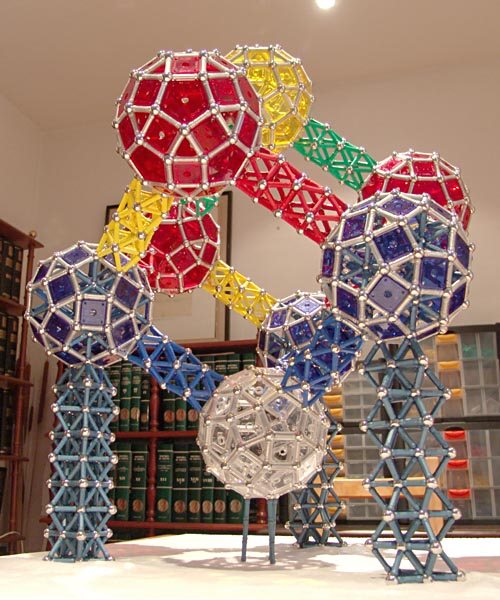
The Brussels' Atomium, view 1
3453 pieces: 828 balls, 2271 rods, 60 pentagons, 294 squares (18.51 kg)
|
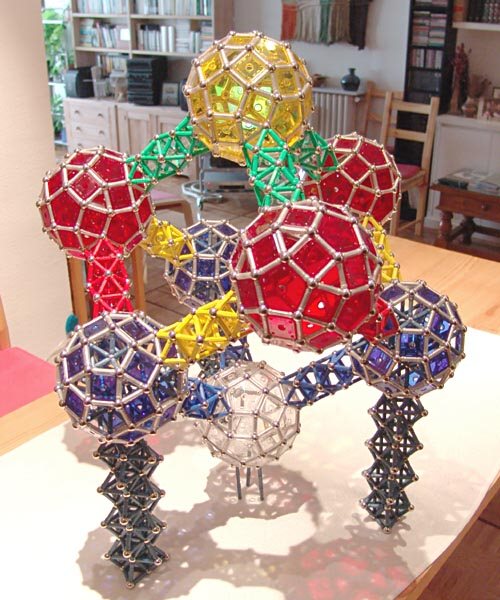
The Brussels' Atomium, view 2
|
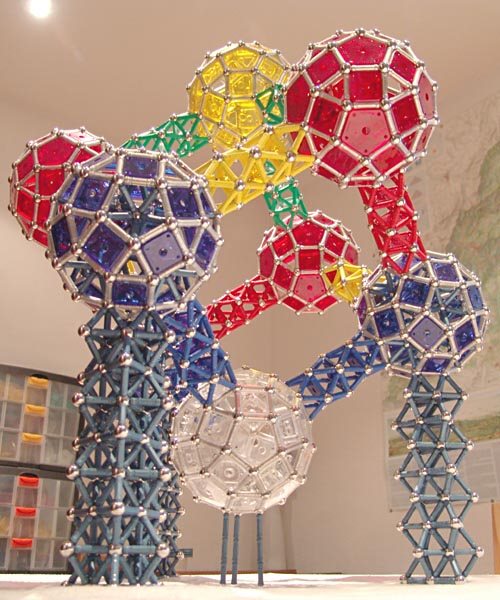
The Brussels' Atomium, view 3
|
The three three-rod supports on which the bottom sphere seems to rest, in the pictures above, are not indeed required once the model is completed. A support is required at first, when the weight of the bottom sphere would bring the other three down (see the following picture).
The bottom sphere is a normal rhombicosidodecahedron (see a construction method). The three blue spheres are reinforced rhombicosidodecahedra (see construction methods 1 and 2). Using a reinforced version for these three spheres is the key to succeeding in building this model. Before learning the reinforced version, I failed many times, as precisely those spheres always collapsed. In my opinion, the remaining spheres in the model should be of the normal version.
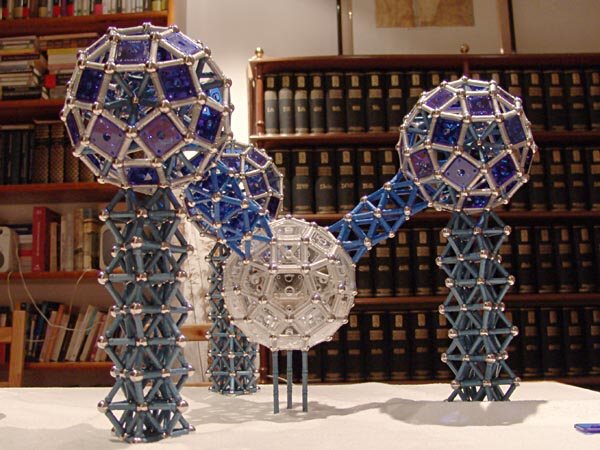
Construction of the Brussels' Atomium, phase 1
|
The columns are made around a core of triangular antiprisms, each with a regular tetrahedron added to each of the pointing-up triangular faces, which allows for connecting each level with the previous one with three rods. In this way, the columns are stronger and more stable.
In the following picture, tubes have been added to the three upper spheres, on which the next three spheres will rest:
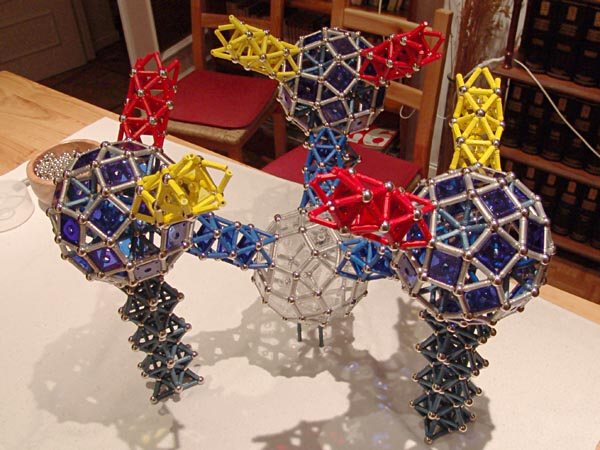
Construction of the Brussels' Atomium, phase 2
|
I became too cautious because of the many previous failures, so I did not dare to put in their place the next three spheres without a supplementary support, supposedly required until the top sphere closed and held the whole thing.
However such supports are plainly not required. Version 2, below, was built without the use of any support at all at this phase:
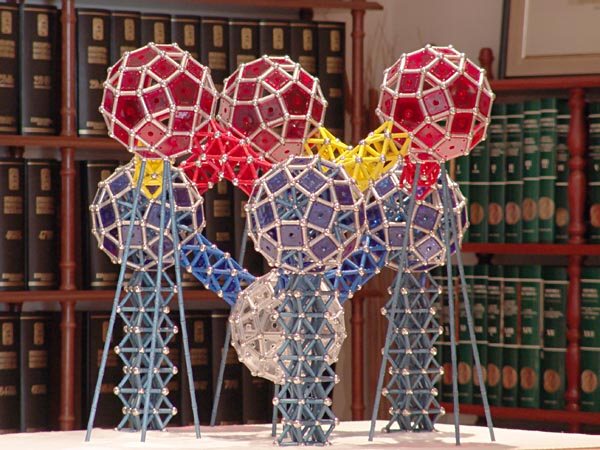
Construction of the Brussels' Atomium, phase 3
|
I have no more pictures available, but what remains is easy: three tubes from the three red spheres converge at the last, top sphere. In view 2 above this final phase is clearly shown.
Here follows a less colored version, which I built at a later date. As I said above, no supplementary supports were used at phase 3 of the construction. Indeed, once the reinforced rhombicosidodecahedra are used, the model is quite solid (this one even stood several children attacks).
I used a different column design, neater and nicer, in my opinion. The columns are made up of cuboctahedra connected by their triangular faces, with a halved one and a hexagonal prism as base.
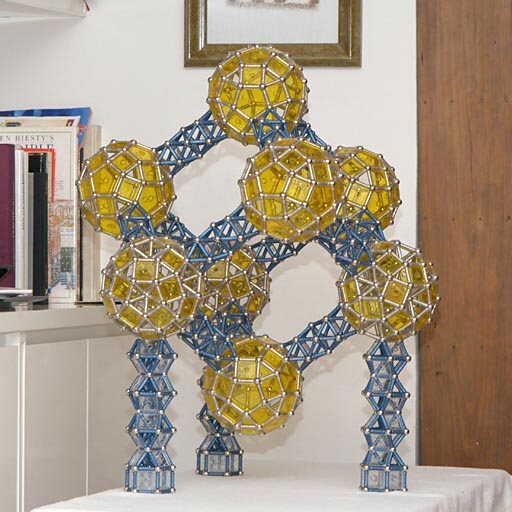
The Brussels' Atomium, version 2, view 1
3471 pieces: 816 balls, 2202 rods, 60 pentagons, 393 squares (18.26 kg)
|
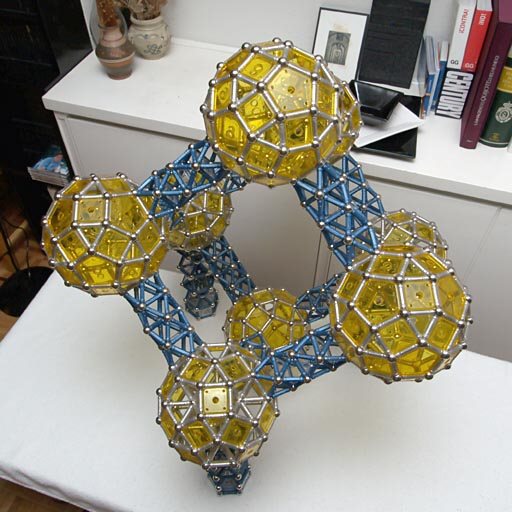
The Brussels' Atomium, version 2, view 2
|